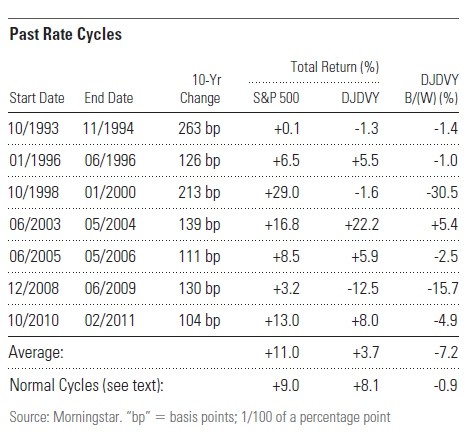Will Rising Interest Rates Kill These Dividend Stocks
Post on: 1 Май, 2015 No Comment

As economic activity picks up, dividend stocks are falling on fears that the Federal Reserve will tighten monetary policy by raising interest rates. Over the last year, the yield on 10-year Treasury notes increased from 1.85% to 2.74%. As Warren Buffett likes to say, In economics, interest rates act as gravity behaves in the physical world. At all times, in all markets, in all parts of the world, the tiniest change in rates changes the value of every financial asset.
Interest rates’ effect on bonds is the most obvious. As interest rates rise, bond prices fall — and vice versa. Less obvious is the effect on bond-like instruments, like stocks that pay large dividends. The value of all equities declines as interest rates rise because future cash flows must be discounted at a higher rate; but the effect is particularly large on dividend stocks like Philip Morris International ( NYSE: PM ). General Mills ( NYSE: GIS ). and McDonald’s ( NYSE: MCD ) .
Over the last year, as interest rates on U.S. government debt rose, the iShares Dow Jones U.S. Select Dividend ETF significantly underperformed the broader market.
Source: Bloomberg. Orange is 10yr T-note. Green is Dow Dividend Select. Yellow/Orange is S&P 500.
Moreover, Janet Yellen, chairman of the Federal Reserve, insinuated that the central bank could raise the federal funds rate (the basis for all interest rates) in the second quarter of 2015. Although rate increases will likely be slow and measured, the upward pressure on yields necessarily puts a downward pressure on prices. If investors can get a 3% yield owning 10-year Treasury notes — thought of as a risk-free asset — they would be less likely to buy a dividend stock yielding 3% that also comes with the risk of capital impairment. As a result, dividend yields will rise, meaning the stock prices will fall.
Three dividend stocks threatened by interest rate increases
Dividend investors tend to be long-term investors, content to buy and hold a stock as long as it pays a strong and increasing dividend. However, even long-term dividend investors will have a large opportunity cost if they buy before rates increase.
For instance, Philip Morris pays a quarterly dividend of $0.94 per share. That translates into $3.76 per year. At $80 per share, the stock offers a 4.7% dividend yield — or about 2 percentage points higher than the 10-year Treasury note. Philip Morris is a popular dividend stock. It does not have many growth opportunities because it operates in a declining industry, but it throws off lots of free cash flow.
Since a significant part of Philip Morris’ return comes from its dividend, the stock may be particularly sensitive to changes in interest rates. If interest rates increase and investors demand a 5.5% dividend yield from Philip Morris, its stock price will fall 14.5% to $68.36 per share. (Here’s the math: $3.76 dividend divided by 5.5% yield = $68.36.)
The story is similar for other dividend stalwarts. General Mills is another blue chip stock that pays a generous dividend. It pays $0.38 per quarter, or $1.52 per year. The stock trades at about $51 per share, so it yields slightly less than 3%.

The company pays out about 50% of its earnings in dividends each year, so a huge chunk of a General Mills investor’s return comes from the dividend. However, the company has grown earnings per share at close to 8% per year over the last decade, giving it the potential for meaningful capital gains. Still, if General Mills’ stock is repriced for a 3.5% yield, the stock price will fall nearly 15% to $43.42 ($1.52 / $43.42 = 3.5%).
Finally, McDonald’s is also vulnerable to interest rate hikes. Its $0.81 quarterly dividend adds up to $3.24 per year. At $96 per share, the stock offers a 3.4% yield. Like Philip Morris and General Mills, McDonald’s trades partly based on its dividend yield because its payout ratio is particularly high — more than 50% in the last two years.
McDonald’s is coming off a disappointing year, and comp growth continued its slide into 2014. If the business deteriorates further, it may not be able to increase its dividend as much as it usually does, causing the stock to sell off. A rise in the general level of interest rates would compound the problem. A 50 basis point increase in the stock’s dividend yield would lead to a 13% decline in its stock price — an unwelcome event for all shareholders.
A small change in dividend yield can lead to a big change in price for dividend stocks. With the fed funds rate at rock bottom and signs that economic activity is picking up, interest rates are bound to rise — and dividend yields along with them. As a result, dividend investors should carefully consider whether now is the right time to buy a stock simply for its dividend, or if it is better to wait for rates to rise before taking a position.
Nine rock-solid dividend stocks you can buy today
One of the dirty secrets that few finance professionals will openly admit is the fact that dividend stocks as a group handily outperform their non-dividend paying brethren. The reasons for this are too numerous to list here, but you can rest assured that it’s true. However, knowing this is only half the battle. The other half is identifying which dividend stocks in particular are the best. With this in mind, our top analysts put together a free list of nine high-yielding stocks that should be in every income investor’s portfolio. To learn the identity of these stocks instantly and for free, all you have to do is click here now .














